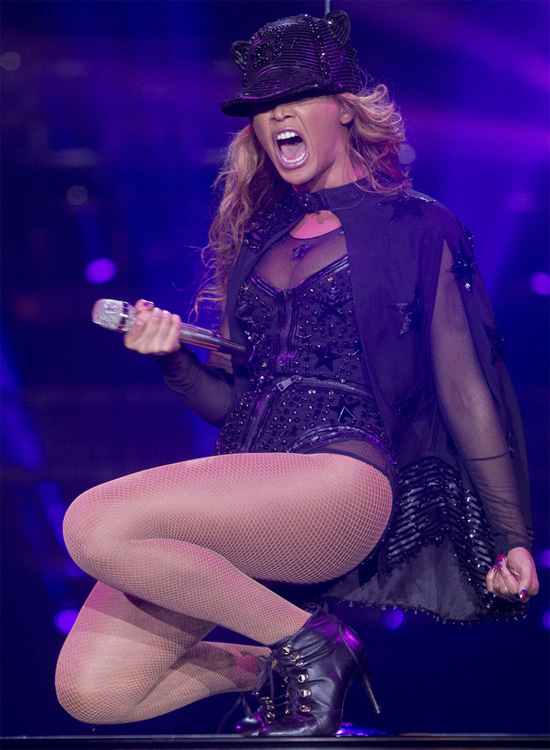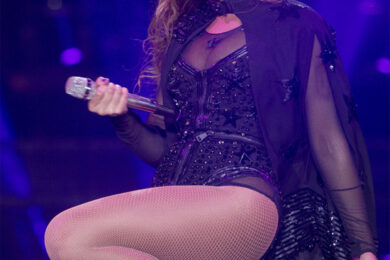Beyoncé drinks Pepsi, wears the clothes she’s selling, asks us "What is seduction?" ("Seduction is independence") in an advert for perfume, and drinks more Pepsi, on screens the size of buildings. And after 30 minutes of this pre-show product reel, I feel like Freddy in The Master: arms bound and begging his keeper to just please "say something that’s true". I’ll be your plastic toy.
Then we’re into opening salvo, ‘Run The World (Girls)’, and hark – the main screen begins its transforming assault, and what follows is 2 hours and 25 songs-worth of hi-tech artist-to-machine synergy. In the starry insides of this buried mothership, everybody is dancing. Everybody. But in the stands, there are women behind me who are falling. They’re an amusingly spirited crew, our upstairs neighbours, so I’m already a part-time spectator when, during ‘Single Ladies’, a misjudged pirouette puts fresh air between concrete and stiletto. So she’s tipping backwards into nothingness and contemplating the inevitable, and as the O2’s hairy gradient takes her, a would-be saviour attempts a grab, and ends up making the same journey straight down. So now they’re falling.
Thankfully the women are soon returned to their seats. What they then do is hug and laugh, and soon we’re all laughing, because we’re camaraderie-starved Londoners. And I’m still watching as, Stargate-like, the wonder-turn of this electric circus imprints on their faces, in cycling, violent patterns of red neon, or sapphiric TV flicker, and suddenly I feel very, very tired. Suddenly I feel awesomely aware of precisely how much just happened in the time it took them to fall; all those years of business acumen, marketing knowhow and technological mastery, distilled into ribbons of accelerating efficiency, and coming together a hundred times or more in the one second it took for the women to travel from their row to the one in front of us.
A Beyoncé concert is a good night out like you’ve never experienced, and I can only imagine the quasi-religious effect such expense is having on the teens here, who were already in the throes of idolatry just walking to school. And to second guess such a marvel, especially in the company of 20,000 insanely happy people, makes me feel like a self-defeating, over-thinking pseud, needlessly resisting what is, quite obviously, an unholy thrill: a stone-cold marvel of modern science struck 500 yards in every direction, from the hands of one extraordinary human being. But as much as I love it, I hate it ten times more. Because, as the ladies fall, so too does an entire edifice of American specialisation. And chalk it up to my innate laziness, but that makes me tired. This woman makes me tired, with her show that is at once a violation of your devotion and completely loveless; both thrilling and utterly chilling.
In the field of elite stadium pop, Beyoncé’s stage-set is, in fact, relatively modest. I mean, Gaga had a castle. Like, literally, a proper to-scale fortress. But if the function of arena production design is to blow minds, medieval keeps are no match for the Doomsday machine Beyoncé brings: a panoramic super-screen like a prostrate 18-wheeler which, in concert with the human activity in its foreground, is able to twist your head into a space neither real nor entirely unreal. Imagine the finest promotional visuals money can buy, spilling out of the frame and into real life, like brand exposure as home invasion, or a music promo in real time. During the regular interludes we are shown five minute shorts that simply defy belief. We’re talking about multi-million dollar films, comprising legions of extras, an array of international locations, cutting edge graphics and an endless supply of Givenchy-designed costumes. In their dazzling complexity and Hollywood production values, so cinematic are these vignettes that, in my head, Beyoncé is consigned to that second level of reality cinema represents. Which means that every time she stops being a figment of celluloid and returns to the stage in glorious 3D, it’s completely head-fucking. And then when she’s on stage, things get really complicated: during ‘1 + 1’ the screen becomes a sunset for Beyoncé to peer at wistfully.
Within about five minutes of the show starting, the lines are blurring. You barely know if what you’re watching on screen is a video promo, a short film or an advert for any number of products: clothing, a lifestyle, Beyoncé the brand, or the Mrs Carter tour itself. In terms of servicing the mechanics of the concert the screens, shuffling between background visual, lighting effect, and visual overture, are designed to advance the show’s meta-narrative (the tour’s ‘story’ centres around Beyoncé as an Elizabethan royal), a story which itself both dovetails and clashes with the narrative the ‘real Beyoncé’ is guiding us through on stage. The set is DJ-mixed, with many of the party tunes rearranged into mashup-style melees – riddled with machine gun finales, stretches of pacey dance beats and surprise song-samples (Fleetwood Mac’s ‘Everywhere’ makes a cameo appearance). ‘Get Me Bodied’, for example, has its quasi-dancehall rhythms chopped into a stutter. But to make matters worse, the music is synced with the visuals. And after ‘Baby Boy’s glitched-out climax prompts a psycho-strobic lightshow on screen, when the screen then crashes like a detuned TV, your head is roughly in the same condition. The result is a diminished sense of reality, which gives way to sensory disorientation and a very real sensation of being brainwashed.
The show’s real genius lies in its ability to reduce live music to a shorthand of big reveals. One after the other, each song intro is exploded into multidimensional events of audio-visual sci-fi. The impression, then, is that the concert is opening anew over and over again, with each Pandoran curtain-raiser primed by the shorts, which effect either a drumroll-esque sense of anticipation or outright tension. I suppose that if I’m screaming along with the rest of them, I’m screaming from beneath the waves. On the screen are flashing numbers, as Knowles’ disembodied, glitching voice counts down from ten to zero. So, time’s up. The screen goes black, then begins looping psychedelic shapes as Beyoncé appears, and instead of the expected ‘Countdown’ the iconic brass palaver of ‘Crazy In Love’ erupts, and ploughs a line right through us and up the ways, into the sky-scraping top floors of the O2’s bowl. Then, at the song’s completion, great plumes of dry ice gush from the floor beneath Knowles, swallowing her whole. And all the while she’s telling us, "It’s not over yet, the show is not over yet." The jets cut out and as the dry ice dissipates, Beyoncé rises, as ‘Single Ladies (Put A Ring On It)’ is both heard and seen in innumerable ways: across quadrophonic channels and then overhead, on three secondary screens, each window carrying the same image of a face I know and then can’t erase when, four hours later, I’m trying to sleep in the darkness of my room in Bethnal Green.
Of course, the flash and blitz is only what I remember most vividly. There’s a whole other side to the Beyoncé live experience; one involving a series of ballads with Knowles enacting a messianic compassion, or the enlightened serenity of a seasoned aesthete, as if ruthless professionalism makes the world a better, more beautiful place. An angelic backlight makes a silhouette of the star, as a rocked-up ‘Halo’ incorporates a rendition of Whitney’s ‘I Will Always Love You’. Then there’s ‘Irreplaceable’, an acoustic-strummed fix of post-Alanis Morissette alt-rock where Knowles gets to come over all golden naturalism, despite the fact that two minutes earlier, garbed in sparkling purple cat suit, she was literally air-mailed (winch-aided) into the VIP enclosure. Which has a way of making her uneasy attempt at intimacy on the area’s walkway all the more forced. "This is my favourite part of the show" she tells us, "I get to feel close to you guys."
But it’s not all spirit-crushing, anti-art cynicism. As a career’s worth of hits roll through the eaves, I’m surprised to learn there actually does exist a signature ‘Beyoncé sound’; a house style which, in the era of production-house hip hop and rave-&B heterogeneity, suggests that Knowles is, if not an auteur, certainly part of a dying breed. It’s possible to discern a through-line spanning DC’s ‘Jumpin’, ‘Crazy In Love’ and on into the more sophisticated productions like ‘Single Ladies’ and ‘Countdown’ – their unifying style a kind of brass-tronic, deceptively percussive form of mega-pop, in part a product of post Timbaland R&B and in part a digi-diced, whirling reboot of big band soul. It’s a neat combo: fulfilling pop’s dance requirements, facilitating and modernising Knowles’s gospel melismas, and, not least, working like gangbusters in a live setting. ‘Freakum Dress’ is particularly striking: it seems suspended in one long badass-funking YAWP of crash cymbal, trumpet and cascading vocal cuts.
More apparent in a live setting, too, is one aspect of Knowles’ back catalogue that’s often overlooked when folk get to comparing the Queens Of Pop. Throughout the 00s in the field of superstar pop, it occurs that Beyoncé has been somewhat of a last bastion for MOBO styles. While you get the feeling her famed ‘physical passion’ (Uncle Percy hacks, now’s your chance to talk about her thighs) is in compensation for the music’s vaguely unfeeling (or vaguely asexual?) core, it’s also clear that the funk and spitting percussive detail Knowles is writhing to has, in fact, not been a given in pop; not perhaps since the R&B boom at the turn of the century, and especially not since 2010 and the four-to-the-floor horrors Guetta has visited on R&B’s sense of swing. Then there’s Rihanna, who shelved her Caribbean influences in favour of rave and Depeche Mode rock, while Kayne swapped soul-sampling hip hop for a more rootless electronic style. Consider also Minaj’s big play for global dominance, Pink Friday, an album that divides its running time between Young Money-esque de-funked abstraction and the type of Middle American tween-pop Taylor Swift makes.
Though showcasing Knowles’ vocals, admittedly the old-school soul efforts like ‘Love On Top’ remain earthily dreary tonight. Rather it’s her strikingly technical club hits that shine; proof, I suppose, that domination in pop also means keeping abreast of the ever-shifting parameters of black production genius. ‘Diva’ is light years on from the likes of ‘Survivor’ while the Pepsi-funded ‘Grown Woman’ is a never-before-heard pop hybrid of Ethiopian rhythms (reportedly) and a kind of Americanised strain of highlife. It’s genuinely cheering tonight, possibly because it’s the least overbearingly fierce dance track Knowles has ever produced, due mainly to its air of sub-Saharan ebullience. Meanwhile ‘Run The World (Girls)’ is sounding odder and odder by the day. Written by The-Dream and produced by Diplo, tonight its unique clatter becomes a frenzy of fizzy drumlines and Amazonian grunts.
But when all’s said and done, I’m kind of reaching here, in the manner of a sweaty apologist. Because it makes me tired, this competition. And though it’s been two days since the concert, I still feel enveloped in some kind of a wearying fug. Recently I watched Marathon Man for the first time, and in one scene a character quotes from a poem by Alfred Tennyson. I Googled the poet and found the quoted line: the poignant jag in a weary prayer for mercy in the face of civilisation and its progress eternal: "Let us hush the cry of Forward! Till ten thousand years have passed."



